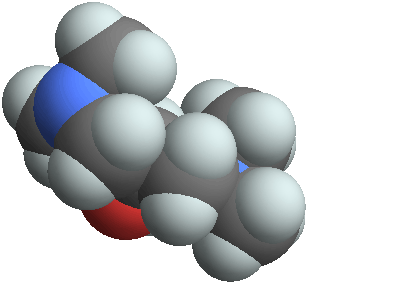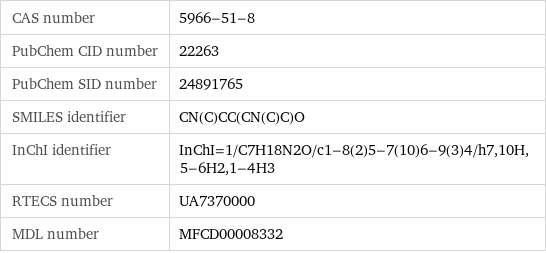Input interpretation

1, 3-bis(dimethylamino)-2-propanol
Chemical names and formulas

formula | (CH_3)_2NCH_2CH(OH)CH_2N(CH_3)_2 Hill formula | C_7H_18N_2O name | 1, 3-bis(dimethylamino)-2-propanol IUPAC name | 1, 3-bis(dimethylamino)propan-2-ol alternate names | 1, 3-bis(dimethylamino)-2-hydroxypropane | 1, 3-bis(dimethylamino)isopropanol | 1, 3-bis(dimethylamino)propan-2-ol | N, N, N', N'-tetramethyl-1, 3-diamino-2-propanol | N, N, N', N'-tetramethyl-2-hydroxy-1, 3-diaminopropane mass fractions | C (carbon) 57.5% | H (hydrogen) 12.4% | N (nitrogen) 19.2% | O (oxygen) 10.9%
Lewis structure

Draw the Lewis structure of 1, 3-bis(dimethylamino)-2-propanol. Start by drawing the overall structure of the molecule: Count the total valence electrons of the carbon (n_C, val = 4), hydrogen (n_H, val = 1), nitrogen (n_N, val = 5), and oxygen (n_O, val = 6) atoms: 7 n_C, val + 18 n_H, val + 2 n_N, val + n_O, val = 62 Calculate the number of electrons needed to completely fill the valence shells for carbon (n_C, full = 8), hydrogen (n_H, full = 2), nitrogen (n_N, full = 8), and oxygen (n_O, full = 8): 7 n_C, full + 18 n_H, full + 2 n_N, full + n_O, full = 116 Subtracting these two numbers shows that 116 - 62 = 54 bonding electrons are needed. Each bond has two electrons, so the above diagram has all the necessary bonds. There are 27 bonds and hence 54 bonding electrons in the diagram. Lastly, fill in the remaining unbonded electrons on each atom. In total, there remain 62 - 54 = 8 electrons left to draw: Answer: | |
3D structure

3D structure
Basic properties

molar mass | 146.23 g/mol phase | liquid (at STP) boiling point | 178 °C density | 0.897 g/cm^3 solubility in water | very soluble
Units

Liquid properties (at STP)

density | 0.897 g/cm^3 refractive index | 1.442
Units

Chemical identifiers

CAS number | 5966-51-8 PubChem CID number | 22263 PubChem SID number | 24891765 SMILES identifier | CN(C)CC(CN(C)C)O InChI identifier | InChI=1/C7H18N2O/c1-8(2)5-7(10)6-9(3)4/h7, 10H, 5-6H2, 1-4H3 RTECS number | UA7370000 MDL number | MFCD00008332
Safety properties

flash point | 110 °C
Toxicity properties

RTECS classes | other